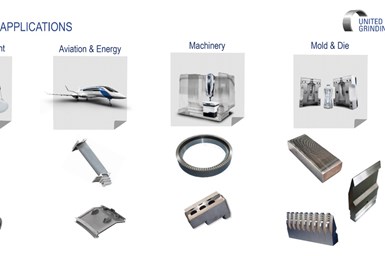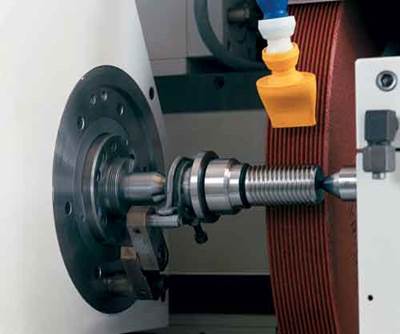Not the Same Old Grind
A recent press event showcased United Grinding’s wide range of machines available for mold manufacturing whether the mold builder needs perfectly polished radii for food and beverage applications or the multi-axis flexibility for highly precise mold threads.

The S31 is a cylindrical grinding machine for the individual, small-batch, and large-scale production of short to long-sized workpieces.
Moldmaking is characterized by small batch sizes and short changeover times with increasing complexity and harder materials. Almost every mold component needs to be ground, including mold base plates, sprue bushings, leader pins, bushings, core and cavity plates, inserts, lifters, slides, gibs, wear plates, ejector pins, core pins, date wheels, etc. So, a mold shop may be equipped with several different automatic and manual surface grinders—manual surface grinder, CNC surface grinder, tool-and-cutter grinders, jig grinder, centerless grinder, ID-OD grinder and Blanchard grinder.
United Grinding offers a wide range of machines available for this demanding manufacturing niche whether the mold builder needs perfectly polished radii for food and beverage applications or the multi-axis flexibility for highly precise mold threads—the MÄGERLE, BLÖHM, STUDER, SCHAUDT and MIKROSA grinding machines.
United Grinding held its IMTS press event virtually as part of IMTS Spark, and they get moldmaking. This company understands that mold and die manufacturing is a job for specialists with unique challenges that the right grinding machine can tackle.

Here are two key questions answered during the press conference:
Q: The surface grinding department in a mold shop is critical to the quality of a mold. Surface finish is very important in moldmaking and grinding is a key process for this challenge, so what new or improved features and functions does United Grinding technology offer to address the surface finish needs of today’s mold builders?
A: Mold builders are inherently craftspeople and often one person is working a manual machine to get the surface finishes he requires. All of our equipment has the flexibility to change grinding wheels automatically. For example, start off with a 46-grit grinding wheel and take it all the way down to a 80 to 220-grit grinding wheel to improve surface finishes.
We also offer the ability to introduce hydrostatic guideways into the grinders to add additional dampening characteristics and improve surface finishes. We also have dressing techniques such as putting a CNC disc dresser on the table to dress the grinding wheel at any speed desired—traversing across the wheel from 1 inch per minute to even slower than that to close up that grinding wheel and give a good surface finish. We also have refined our acoustic, monitoring and balancing systems to reduce vibration, helping improve surface finishes.
Q: You offer MÄGERLE, BLÖHM, STUDER, SCHAUDT and MIKROSA grinding machines for mold and die, but what is the most popular grinding machine for moldmaking, and why?
A: First, any BLÖHM Planomat-style grinder is the most flexible in mold and die work for squaring up mold inserts and putting different features into the mold insert. It is very flexible. The BLOHM human-machine interface (HMI) makes it very simple for an operator to engage in the machine, program the machine and grind the part. On the HMI the macros range from dressing macros to changing feeds and speeds on the dressing to changing feeds and speeds on the actual grinding program.
Second, the Studer S31, over the years and the latest generation due to its high precision, infinite B axis and multiple tools. The S31 is a cylindrical grinding machine for small to large workpieces in single, small and large series production. It has a distance between centers of 400mm (15.7") / 650mm (25.6") / 1,000mm (40") / 1,600mm (63") and a center height of 175mm (6.9"). It can machine workpieces with a maximum weight of 150kg (330lbs). Thanks to an upgradeable modular system, the S31 can be adapted to match precise requirements. The swiveling wheelhead allows you to externally, internally and face grind workpieces in a single clamping – with a high-resolution B-axis of 0.00005°. Its foundation is a machine base made of solid Granitan® S103.
Related Content
Moldmakers Deserve a Total Production Solution
Stability, spindle speed and software are essential consideration for your moldmaking machine tool.
Read MoreHow to Produce More Accurate Molds and Reduce Rework
Patented micro-milling process for manufacturing steel plate flat and parallel helps mold builders shorten mold build times and increase accuracy.
Read MoreMold Innovations Power Unique Auto Lighting Elements on Hummer EVs
Diamond machining, electroforming of micro-optical inserts and modified latch-lock system help injection molds produce unique forward lighting elements.
Read MoreTips for Tackling Mold Design, Machining, Cutting Tool and Wear Challenges
Tips for tasks ranging from reducing risk in part design and taking advantage of five-axis machining to refining cutting tool performance and reducing wear with guiding and centering systems.
Read MoreRead Next
What Moldmakers Should Know about Cylindrical Grinding
Reducing costs, producing superior surface finishes and providing high flexibility are just a few of the advantages achieved with cylindrical grinding in mold manufacturing.
Read MoreAre You a Moldmaker Considering 3D Printing? Consider the 3D Printing Workshop at NPE2024
Presentations will cover 3D printing for mold tooling, material innovation, product development, bridge production and full-scale, high-volume additive manufacturing.
Read MoreReasons to Use Fiber Lasers for Mold Cleaning
Fiber lasers offer a simplicity, speed, control and portability, minimizing mold cleaning risks.
Read More






















